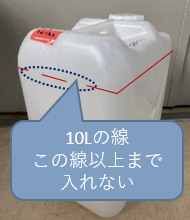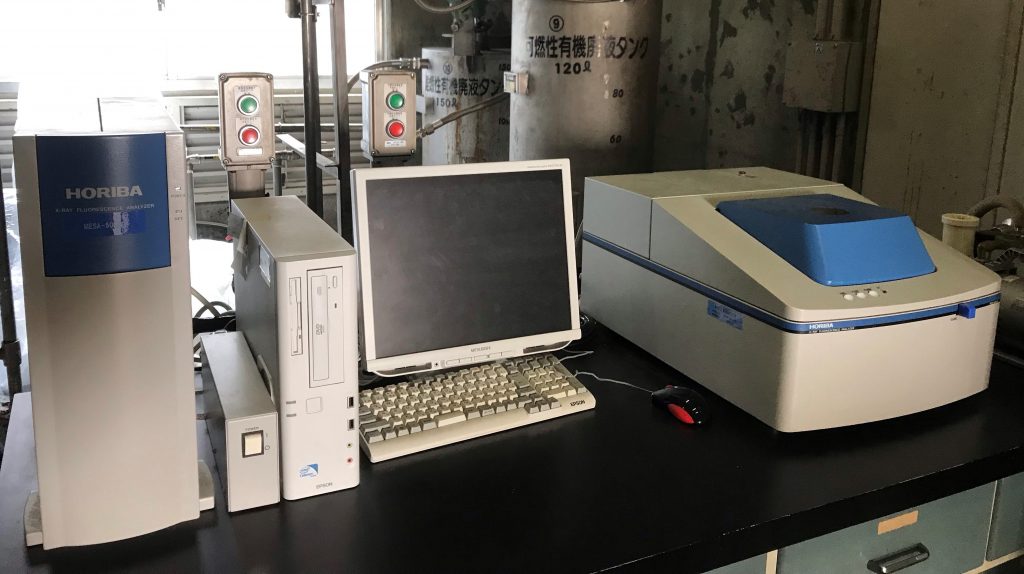Organic liquid waste treatment at Center for Environmental Science
We installed an organic liquid waste incineration plant manufactured by Sunray Reinetsu Co., Ltd. in 1977, which was upgraded in 1999 to comply with stricter dioxin regulations. However, it had been in operation for about 19 years and had become decrepit, making it difficult to continue its operation. Therefore, in September 2017, we decided to outsource the treatment to an external contractor.
The amount of waste generated by universities is not as large as that of general industrial waste generated by factories. However, due to the wide variety of sources, it is extremely diverse in terms of form, composition, and other qualitative aspects. The amount of waste also fluctuates according to the timing of research and education activities.
Considering the particularity of the wastes in universities, it is most important to separate and store the experimental liquid waste appropriately and safely in each laboratory where it is generated, in order to fulfill the responsibility of the dischargers.
About Organic Liquid Waste
Organic liquid waste containing reagents, solvents, etc. generated in the course of education and research activities fall under the category of “specially controlled industrial waste” as defined by the Waste Management and Public Cleaning Law, and must be managed more strictly than ordinary industrial waste.
If it contains legally hazardous substances, it is classified as “specified hazardous industrial waste” among the “specially controlled industrial waste”.
Discharged liquid wastes must be tracked and controlled during all stages of transport and treatment, and if the discharger’s mismanagement causes a serious accident, the discharger will be held responsible.
Flow of organic liquid waste treatment
Classification and storage
▼
Organic liquid wastes should be stored separately according to the classifications given in the table below.
Note that there are some substances prohibited from mixing.
Be sure to use the standard 10L plastic containers specified by the college. Do not use damaged or deformed containers, and do not put more than 10 litters.
Click here for more information about precautions during storage.

Information
▼
Center for Environmental Science outsources the disposal of organic liquid waste three times a year, around May, October and January.
Each time all KIT members will be notified by e-mail, and those who require organic liquid waste treatment are encouraged to apply through the web-based application system.
Carry-in, analysis and pretreatment of organic liquid waste
▼
Bring the organic liquid waste to Center for Environmental Science on the designated date for analysis. If the pH is not between 6 and 8, neutralization is required.

Pick up the instruments for analysis at the reception desk.

Check the pH, specific gravity, and combustibility.

Use an X-ray fluorescence spectrometer to measure the concentration of chlorine and sulfur.

After analysis and pretreatment, label the container.
transportation and disposal of organic liquid waste
▼
The discharged organic liquid waste is transported to a treatment plant by the industrial waste disposal company for incineration and then disposed of in a landfill.
The person responsible for the discharge must be present on the day of transport.
returning containers
After the disposal of the liquid waste is complete, the containers will be returned to the Center for Environmental Science.
The date will be announced to all discharge managers, so please collect the containers you own.
Classification of Organic Liquid Waste
| Classification | ||
|---|---|---|
| ① Combustible organic waste liquid | organic solvent | |
| ② Combustible organic waste liquid containing hazardous substances | organic solvent containing hazardous substances | |
| ③ Non-combustible organic waste liquid | Aqueous solutions containing organic solvents or organic compounds | |
| ④ Non-combustible organic waste liquid containing hazardous substances | Aqueous solutions containing organic solvents or organic compounds and hazardous substances | |
| ⑤ Highly halogenated organic waste liquid | Organic liquid waste with a halogen concentration of 10 w/w% or more | |
| ⑥ Oils | Mineral oil such as kerosene, heavy oil, machine oil, etc., and animal and vegetable oil | |
| ⑦ Photographic effluent | Photo developing solution, etc. | |
| ⑧ Waste liquid that cannot be mixed | Highly reactive liquid waste, double layer separation liquid waste |
Hazardous substances
In the classification of organic liquid wastes, a total of 17 substances are designated as “hazardous substances”, including chloroform and 16 substances designated as “specific hazardous industrial wastes” by law. Please see the table below.
| chloroform | trichloroethylene | tetrachloroethylene |
| dichloromethane | tetrachloromethane | 1,2‐dichloroethane |
| 1,1‐dichloroethylene | cis-1,2-dichloroethylene | 1,1,1‐trichloroethane |
| 1,1,2‐trichloroethane | 1,3-dichloropropane | thiuram |
| simazine | thiobencarb | benzene |
| selenium | 1,4-dioxane |
Substances that should not be mixed to organic liquid waste
- Organic materials with a particularly low flash point, such as ether, carbon disulfide, petroleum ether, and so on.
- To avoid fire hazards during storage and transportation, the flash point must be lowered. Add a high boiling point solvent to reduce the concentration of low boiling point compounds to 20% or less.
- Substances that pose a risk of explosion, such as peroxides, diazo compounds, and so on.
- Radioactive substances.
- Specified hazardous substances, such as organic phosphorus, mercury and its compounds, PCB, and so on.
- Corrosive substances, such as strong acids, strong alkalis, alkoxides, and so on.
- Please adjust pH to 6-8 with sodium carbonate if acidic, or acetic acid if alkaline, and filter through a 100-mesh wire mesh. Do not use organic amine or ammonia water for neutralization.
Precautions for Separate Storage
Your organic liquid waste will be stored at Center for Environmental Science and then transported long distances by truck by an outside processor. To ensure safety during storage and transportation, liquid waste should be stored in 10L polyethylene containers designated by the KIT.
When purchasing polyethylene containers, please place an order through the university’s financial accounting system. When purchasing polyethylene containers, contact the Center for Environmental Science.
Never use a damaged or heavily deformed container.
Before delivery, be sure to tighten the cap strongly and tilt the container to check for leaks.
As a rule, dispose of polyethylene containers after 3 years.
Application procedures for disposal of organic liquid waste
Organic liquid waste is disposed by an external contractor three times a year, around May, October, and January.
Information will be sent to all members by e-mail.
Those who wish to dispose of organic liquid waste should apply through the web-based application system, https://kit-wlas.net/app/, within the application period. Please log in with the account distributed to your laboratory.
The fields to be entered are as shown in the table below.
| Input items | Input contents | |
|---|---|---|
| Volume | ||
| Category | Select one of the eight liquid waste categories. | |
| Contents | List names of all substances in the liquid waste and their percentages. | |
| Hazardous substances | If any of the 17 legal hazardous substances are included, please list the name of them. | Even if the amount of the substance is small, classify it as "containing hazardous substance". |
| Low boiling point solvent | If any of the following 4 substances are included, please list the name of them. Diethyl ether, carbon disulfide, acetaldehyde, propylene oxide | 4 substances are special inflammable materials as defined in the Fire Service Law. |
| Information on the person responsible for the discharge | Names of the affiliation, laboratory and the person in charge. Contact information; extension number and e-mail address | If it was generated by a student experiment, please enter the name of the experiment as well. |
| Information about the payment source | Administrator, funding source, and purpose | The beneficiary's share of the disposal cost will be collected in the following fiscal year along with that of inorganic liquid waste. |
If you do not have an account or do not know how to use it, please contact Center for Environmental Science.
Contact: Ext. 7976, E-mail haieki(at)environ.kit.ac.jp or environ(at)kit.ac.jp Please replace (at) with @.
After submitting the web application, please go to Center for Environmental Science website, Japanese site, and register the desired date for the delivery and analysis of organic liquid waste.
Bring the organic liquid waste to Center for Environmental Science on the designated date for analysis. and pretreatment.